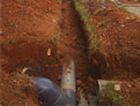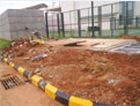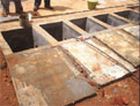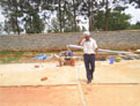Industries
WIPRO technologies, Electronic city, Hosur Road
Water Demand and Supply
This campus hosts a total of 7000 employees and uses 500,000 liters of water daily.
Water is procured from distant bore wells and tankers. Apart from being expensive, all the water being used is essentially groundwater which is unsustainable in the long run.
Issues and concerns
- The storm drain currently carries three kinds of water: rooftop runoff, pavement runoff and chiller unit waste. The quality of each of these is different, with rooftop runoff being the cleanest of all. Can rooftop water be separated from the other two?
- There is a pond with a surface area of approximately 4000 sq m located on the campus. This is periodically topped up with fresh tanker water. The water losses resulting from this are:
- Evaporation: Roughly 8000 kl per year (assuming evaporation of 2m per year).
- Seepage: There are reports of flooding in some basement areas. This is probably due to seepage from the pond.
Potential for rainwater harvesting
| Location | Area (sq.mts.) | Rainwater Harvestable (kilo ltrs.) |
| Surface | 86662.7 | 42031 |
| Rooftop | 14676.8 | 12813 |
| TOTAL | 101339.5 | 54844 |
As seen from the table, there is potential to collect close to 55,000 kilo liters of rainwater annually which represents about 110 days worth of water supply for Wipro.
Strategy
The first step was to segregate the rooftop rainwater from the others.
- Sump tanks: A total of four sump tanks with a combined storage capacity of 3,50,000 liters were built to store the rainwater. Two sump tanks of 1,00,000 liters each were exclusively for the rooftop rainwater while the other two were for the surface rainwater.
- A new pipeline was laid to collect the rooftop rainwater separately. The surface water from the road and the paved areas was collected directly from the storm water drain. The water was adequately filtered prior to storage. In the case of surface rainwater, additional provision was made to segregate the silt and grease.
- Rainwater barrels: Two 5000 liter Sintex tanks were provided to collect roof top rainwater. These are located above the ground and do not require any pumping mechanism to use the water.
- Open well: An open well (five feet diameter) was constructed to collect this seepage and prevent the same from going into the basement. The water thus collected is pumped back to the pond, thus reducing on fresh water usage.
Benefits
- Rainwater stored will be to the extent of 21,000 kilo liters every year.
- Assuming a daily demand of 500 kilo liters, this will suffice for a period of 42 days.
- The problem of seepage in the basement should get reduced/solved since the new open well would collect most of the underground seepage.
- Demand of fresh water for the lake would reduce since the seepage water can be reused.



